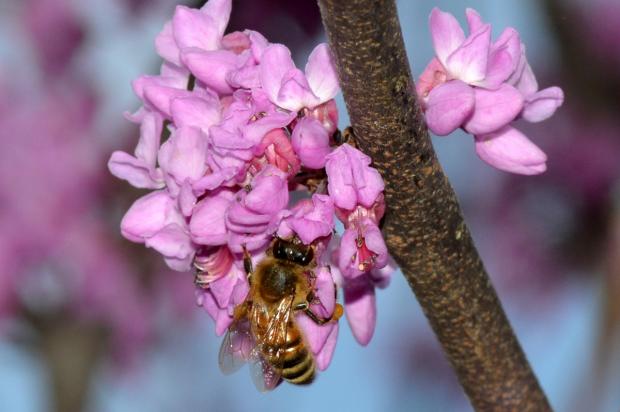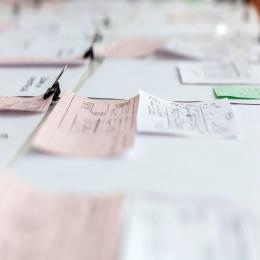
By Terry W. Johnson
There are many reasons why we are so fond of the eastern redbud tree. I suspect our affection for this small, native tree is largely based on its beauty and not what I consider to be one of its most endearing features.
Before the official arrival of spring, redbuds set our backyards and woodlands ablaze with their bright pink to purple blooms. These blossoms burst forth at a time when we are weary of the grayish brown tones that dominate the winter landscape. Consequently, during recent weeks, it was a joy to drive the roads that wind their way through the countryside near my middle Georgia home and be treated to splotches of color dabbed across the landscape by an artist that seemed to be just beginning to paint a magnificent spring mural.
As anyone that has a redbud growing in their yard can attest, the tree's heart-shaped leaves don't appear until the flowers begin to fade. This foliage is attractive in its own right. The leaves are large (3 to 5 inches) and heart shaped. In a yard setting, the canopy of redbuds makes them a great shade tree –refuge from the heat on a hot August day.
In the fall, the leaves turn greenish yellow. While they are not as showy as the leaves of trees such as hickory, the redbud's foliage adds subtle color to the autumn landscape. The color of this native tree is augmented by its seed pods. These long, flat, bean-like pods actually turn purple in the fall. Indeed the contrast between its leaves and pods is striking.
Is it any wonder redbuds were planted near homes in America as early as 1641?
The pods are packed with seeds that are eaten by a bevy of wildlife including, quail, cardinals, rose-breasted grosbeaks, wild turkeys, white-tailed deer and even squirrels.
While all of these traits are commendable, what may be the tree’s greatest virtue is that it’s an important source of food for honeybees and many of our native pollinating insects. In fact, the redbud is so indispensable to these valuable animals some experts rate it as one of our top 10 most important native flowering trees. The high rating stems from the species’ ability to provide these insects with an abundant supply of nectar and pollen when both are often hard to find elsewhere.
The redbud blooms before most trees have even developed leaves, never mind flowers. Indeed, late winter and early spring is a difficult time for pollinators. When they come across a redbud tree in full bloom, the argument could be made that, to these creatures, it is comparable to a starving man stumbling across a buffet of delectable culinary delights.
While it is easy to overlook our animal pollinators, the truth of the matter is they are extremely important to each and every one of us. Wild pollinators such as honeybees, bumblebees, solitary bees, moths, butterflies, flies, beetles and others are responsible for pollinating nearly 90 percent of the world's plants and roughly 75 percent of plants that we humans use for everything from medicines and fiber to condiments, food and beverages. To put in another way, about a third of all of the food we eat relies on animal pollinators.
Entomologists rank bees as our most important animal pollinators. Some 4,000 species of bees are native to the United States alone.
However, in our neck of the woods, if it was not for early blooming plants such as the redbud, many of these pollinators would have a difficult time finding enough nectar and pollen to survive. When this happens, as is often the case in our neighborhoods, wild pollinators are either absent or difficult to find.
Like too many other wild animals, they are suffering from a number of deleterious factors such as habitat loss and degradation and the excessive use of herbicides and pesticides.
A few weeks ago, whenever I walked toward the large redbud tree blooming beside my driveway I gained an appreciation of just how important this tree is to the wild pollinators in my neighborhood. As I approached, I was greeted to a constant buzzing sound created by the untold numbers of bees that had descended on its flowers. The insects ranged in size from rotund bumblebees to tiny solitary bees only a fraction of an inch long. The tree actually seemed to be humming!
The insects were so intent on visiting as many blossoms as they could, they seemed oblivious to me standing a few away. Day after day this scene was repeated until the flowers finally faded and began to drop.
Although I am sure that this same scene could be witnessed in any backyard where redbuds were in bloom, I couldn't help but wonder how many of you stopped and watched the feeding frenzy. If you did, you had a front row seat on this amazing spring ritual that must be seen to be believed. As for me, the experience left me realizing that, for far too long, I have overlooked what may be the most beautiful and important facet of one of our most revered flowering trees.
Terry Johnson is a former Nongame program manager with the Wildlife Resources Division, a backyard wildlife expert, and executive director of TERN, the friends group of the Nongame Conservation Section. (Permission is required to reprint this column. Contact rick.lavender@dnr.ga.gov.) Learn more about TERN, The Environmental Resources Network at http://tern.homestead.com.



















